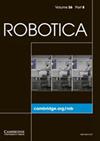Performance evaluation and dimensional optimization design of planar 6R redundant actuation parallel mechanism
IF 2.7
4区 计算机科学
Q3 ROBOTICS
引用次数: 0
Abstract
Aiming at the problems of small good workspace, many singular configurations, and limited carrying capacity of non-redundant parallel mechanisms, a full-redundant drive parallel mechanism is designed and developed, and its performance evaluation, good workspace identification, and scale optimization design are studied. First, the kinematics analysis of the planar 6R parallel mechanism is completed. Then, the motion/force transmission performance evaluation index of the mechanism is established, and the singularity analysis of the mechanism is completed. Based on this, the fully redundant driving mode of the mechanism is determined, and the good transmission workspace of the mechanism in this mode is identified. Then, the mapping relationship between the performance and scale of the mechanism is established by using the space model theory, and the scale optimization of the mechanism is completed. Finally, the robot prototype is made according to the optimal scale, and the performance verification is carried out based on the research of dynamics and control strategy. The results show that the fully redundant actuation parallel mechanism obtained by design optimization has high precision and large bearing capacity. The position repeatability and position accuracy are 0.053 mm and 0.635 mm, respectively, and the load weight ratio can reach 15.83%. The research results of this paper complement and improve the performance evaluation and scale optimization system of redundantly actuated parallel mechanisms.平面 6R 冗余致动并联机构的性能评估和尺寸优化设计
针对非冗余并联机构存在的良好工作空间小、奇异构型多、承载能力有限等问题,设计开发了全冗余驱动并联机构,并对其性能评估、良好工作空间识别和尺度优化设计进行了研究。首先,完成了平面 6R 并联机构的运动学分析。然后,建立了机构的运动/力传递性能评价指标,并完成了机构的奇异性分析。在此基础上,确定了机构的全冗余驱动模式,并确定了该模式下机构的良好传动工作空间。然后,利用空间模型理论建立了机构性能与尺度之间的映射关系,并完成了机构的尺度优化。最后,根据最优尺度制作了机器人原型,并在动力学和控制策略研究的基础上进行了性能验证。结果表明,通过优化设计获得的全冗余执行并联机构精度高、承载能力大。位置重复精度和位置精度分别为 0.053 mm 和 0.635 mm,载重比可达 15.83%。本文的研究成果补充和完善了冗余驱动并联机构的性能评估和规模优化体系。
本文章由计算机程序翻译,如有差异,请以英文原文为准。
求助全文
约1分钟内获得全文
求助全文
来源期刊

Robotica
工程技术-机器人学
CiteScore
4.50
自引率
22.20%
发文量
181
审稿时长
9.9 months
期刊介绍:
Robotica is a forum for the multidisciplinary subject of robotics and encourages developments, applications and research in this important field of automation and robotics with regard to industry, health, education and economic and social aspects of relevance. Coverage includes activities in hostile environments, applications in the service and manufacturing industries, biological robotics, dynamics and kinematics involved in robot design and uses, on-line robots, robot task planning, rehabilitation robotics, sensory perception, software in the widest sense, particularly in respect of programming languages and links with CAD/CAM systems, telerobotics and various other areas. In addition, interest is focused on various Artificial Intelligence topics of theoretical and practical interest.
 求助内容:
求助内容: 应助结果提醒方式:
应助结果提醒方式:


